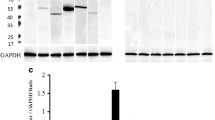Abstract
The presence of H1 and H2 histamine receptors and their associated second messenger systems were studied during the development of the rat mammary gland. In the tissue of the young female, histamine presented a double receptor site as previously described for experimental mammary tumors, namely a high affinity H2 site (Kd=10±2 nM,B max=1068±71 fm/mg prot.), which mediated its effect via the products of phosphoinositide hydrolysis and a low affinity H1 receptor (Kd 1=5±2 nM,B max=188±33 fm/mg prot. andKd 2=41±20 nM,B max=1980±790 fm/mg prot. when characterized with3H-mepyramine), coupled to adenylyl cyclase activation. On the other hand, the mammary gland of the adult rat presented these receptors coupled to the classical second messenger systems described for mammalian cells, that is, the H2 receptor produced an increase in intracellular cAMP levels and the H1 receptor increased the phosphoinositide turnover. We conclude that histamine plays a critical role during development and differentiation of the normal rat mammary gland.
Similar content being viewed by others
References
E. S. Rivera, C. A. Davio, G. P. Cricco and R. M. Bergoc,Histamine regulation of tumour growth. Role of H1 and H2 receptors, In:Histamine in Normal and Cancer Cell Proliferation. (Ed. M. Garcia-Caballero, L. Brandes and S. Hosoda) Advances in the Biosciences,89, 299–317, Pergamon Press, Oxford, (1993).
G. P. Cricco, C. A. Davio, R. M. Bergoc and E. S. Rivera,Inhibition of tumor growth induced by histamine: In vivo and in vitro studies. Agents and Actions Special Conference Issue,38, 175–177 (1993).
M. Garcia-Caballero, E. Neugebauer, F. Rodriguez, I. Nuñez de Castro, A. Heredia, E. Oosting and C. Vara-Thorbeck,Changes in histamine synthesis, tissue content and catabolism in human breast cancer. Agents and Actions27, 227–231 (1989).
C. A. Davio, G. P. Cricco, N. Andrade, R. M. Bergoc and E. S. Rivera,H1 and H2 histamine receptors in human mammary carcinomas. Agents and Actions Special Conference Issue,38, 172–174 (1993).
I. H. Russo and J. Russo,Development stage of the rat mammary gland as determinant of its susceptibility to 7,12-dimethyl benz (a) anthracene. J. Natl. Cancer Inst.61, 1439–1449 (1978).
J. Russo, G. Wilgus and I. H. Russo,Susceptibility of the mammary gland to carcinogenesis. I. Differentiation of the mammary gland as determinant of tumor incidence and the type of lesion. Am. J. Pathol.96, 721–734 (1979).
Author information
Authors and Affiliations
Rights and permissions
About this article
Cite this article
Davio, C.A., Cricco, G.P., Martin, G. et al. Effect of histamine on growth and differentiation of the rat mammary gland. Agents and Actions 41 (Suppl 1), C115–C117 (1994). https://doi.org/10.1007/BF02007792
Issue Date:
DOI: https://doi.org/10.1007/BF02007792




